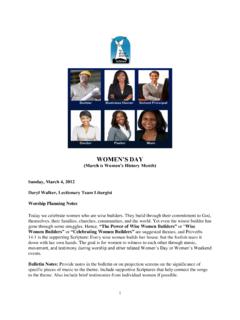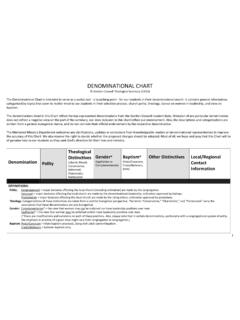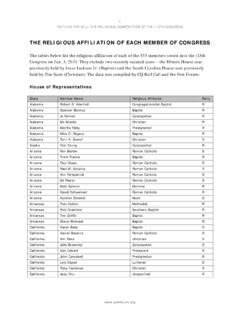Transcription of DRAFT BOOK OF DOCTRINES AND DISCIPLINE FOR A NEW …
1 DRAFT BOOK OF DOCTRINES AND DISCIPLINE . FOR A NEW methodist CHURCH. Version (December 3, 2020). Preface At its 2018 meeting, the Wesleyan Covenant Association (WCA) Global Legislative Assembly authorized the formation of the Next Steps Working Group to envision a revitalized methodist movement within or, or if necessary, outside The United methodist Church. The Next Steps Working Group prepared a DRAFT of a Book of DOCTRINES and DISCIPLINE (D&D) in response to this charge. The WCA Council has reviewed portions of the DRAFT and recommended this document for consideration by a new global traditional methodist church to be launched.
2 This document consists of the following parts: Part One DOCTRINES and Doctrinal Standards 3-20. Part Two Constitution 21-25. Part Three Our Social Witness 26-27. Part Four The Community of God's People 28-40. Part Five The Ministry of the Clergy 41-54. Part Six The Superintendency 54-60. Part Seven Conferences 61-62. Part Eight Connectional Organization 62-70. Part Nine Judicial Administration The document which follows is a work in progress; in no way should it be regarded as final. The WCA seeks to serve those who desire to become part of a new methodist church that upholds the doctrine and ethical teachings of an historic, Wesleyan expression of the Christian faith while reclaiming the qualities of our earlier movement.
3 The WCA anticipates that the formation of such a new methodist church will be an outcome of the 2021 General Conference of The United methodist Church. We anticipate the new methodist church will be governed by a transitional process from its launch until a convening conference is held. The WCA offers this document, including subsequent versions, as a basis for the work of such a convening conference. The D&D addresses essential elements for the formation of a new church, however, it readily acknowledges it will be subject to further amendment and editing. Therefore, the WCA releases this document for review and comment by those who would be interested in shaping and being part of such a new methodist church to enhance the development and sharing of ideas in advance of a convening conference.
4 If you have comments on the DRAFT , please email them to A name for the new methodist church has not been proposed in what follows as that name will be selected by the Transitional Leadership Council of the new methodist church. 1. As the D&D is revised in light of comments received and considered, the WCA Council will publicly share revised versions of it. Each new release will be designated with a version number and release date. This is D&D version , released on December 3, 2020. 2. PART ONE. DOCTRINES AND DOCTRINAL STANDARDS. 101. OUR HERITAGE OF FAITH. As a Wesleyan expression of Christianity, the _____ Church professes the Christian faith, established on the confession of Jesus as messiah, the Son of God, and resurrected Lord of heaven and earth.
5 This confession, expressed by Simon Peter in Matthew 16:16 and Acts 2:32, is foundational. It implies not merely that Jesus is the unique incarnate Word of God, but that He lives, calling all to receive Him as savior, and as the one to whom all authority has been given. This faith has been tested and proved since its proclamation by Mary Magdalene, the first witness to the resurrection. It was defended by the women and men of the early church, many of whom gave their lives as testimony. Their labor, enabled and inspired by the Holy Spirit, resulted in the canon of scripture as the sufficient rule both for faith and practice (kanon in Greek means rule).
6 It formulated creeds such as the Apostles' Creed, the Nicene Creed and the Chalcedonian definition, as accurate expressions of this faith. In the sixteenth century, the Protestant reformers preserved this testimony,insisting on the primacy of Scripture, the necessity of grace and faith, and the priesthood of all believers. Their doctrinal summations, the Augsburg Confession, the Schleitheim Confession, the Articles of Religion, and the Heidelberg Catechism, bore witness to this faith. In the seventeenth and early eighteenth centuries, Pietists in all traditions sought to emphasize the experiential nature of this faith, as direct encounter with the risen Lord.
7 They worked to develop the fruit of this faith, by the power of the Holy Spirit, in individual and communal life. These pietistic movements influenced many in the reformation traditions, including two Anglican brothers, John and Charles Wesley. Through the organizing and publishing of these brothers, a distinctly methodist articulation of Christian faith and life, of practical divinity, emerged. Methodism placed particular emphasis on the universal work of grace, the new birth, and the fullness of salvation, entire sanctification or perfection. Methodists created structures and communities alongside the established church to facilitate the mission to reform the nation, especially the church, and spread scriptural holiness over the land.
8 As ordinary Methodists moved to America, they brought this expression of faith with them. Although Methodism in England remained loyal to the established church until after John Wesley's death, the American revolution dictated the formation of a new church, independent 3. of the Church of England. Accordingly, in 1784, while gathered in Baltimore for the Christmas Conference, the methodist episcopal Church was formally constituted. This new church adopted John Wesley's revision of the Anglican Articles of Religion, the methodist General Rules, a liturgy, and ordained the first methodist clergy.
9 Two other sources of authority were identified: the four volumes that included fifty-three of Wesley's sermons and his Explanatory Notes on the New Testament. When a constitution was adopted in 1808, the Restrictive Rules protected the Articles and General Rules from revocation or change. Other methodist expressions of primitive Christianity and the scripture way of salvation . emerged. German-speaking Americans from pietistic Reformed, Anabaptist, and Lutheran traditions, created organizations with doctrine and DISCIPLINE nearly identical to the English- speaking methodist episcopal Church. The work of Phillip William Otterbein, Martin Boehm, and Jacob Albright, established the United Brethren in Christ and the Evangelical Association.
10 A. number of african American Methodists, including Richard Allen, Jarena Lee, and James Varick, helped establish the african methodist episcopal Church and the african methodist episcopal Church, Zion to better address racial discrimination and the injustices of slavery, while preserving doctrine and DISCIPLINE . Through separations and mergers methodist Christians have preserved testimony to the risen and reigning Christ by holding themselves accountable to standards of doctrine and DISCIPLINE . When the United methodist Church was formed in 1968, with the merger of The methodist Church and the Evangelical United Brethren, both the methodist Articles of Religion and the Evangelical United Brethren Confession of Faith were accepted as doctrinal standards and deemed congruent articulations of this faith.





